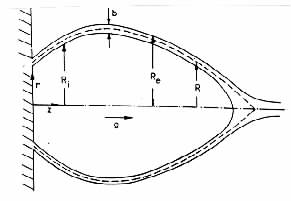
GRUPO DE TÉCNICAS COMPUTACIONALES
EN LA INGENIERÍA
UNIVERSIDAD de MÁLAGA
- Presentación del Grupo en las Jornadas I+D de Industriales (Research Presentation at 2002)
- Chorros Líquidos Anulares (Annular Liquid Jets)
- Miembros del Grupo (Team Members)
- Publicaciones del Grupo: Recopilaciones externas (Publications by external recopilations, incluiding ISI)
Chorros Líquidos Anulares (Annular Liquid Jets)
Annular liquid jets are
thin sheets of liquid falling under gravity which, under certain conditions,
merge in the centerline to become round liquidjets (Figure 1). The volume
enclosed by annular liquid jets has been proposed as a chemical reactor for
scrubbing of radioactive and non-radioactive materials, burning of toxic
wastes, reduction of zirconium from zirconium tetrachloride and sodium, etc.,
because the liquid jet contains the reaction and the gases generated in, for
example, the combustion of toxic wastes may be absorbed by the liquid which may
be collected, purified and recycled so that the combustion-generated gases do
not flow through the jet's outer interface and, therefore, do not pollute the
environment.

Figure 1. Schematic of an annular liquid jet
Most previous studies of
annular liquid jets have been concerned with the analysis of their fluid
dynamics and heat/mass transfer under steady state conditions by assuming that
the axial velocity component of the liquid is governed by Torricelli's
free-fall formula since the geometry of the jet is curvilinear. Moreover,
studies on mass transfer in annular liquid jets have taken profit of the fact
that the binary diffusion coefficient of gases in liquids is much smaller than
that of gases; as a consequence, mass absorption by annular liquid jets is a
rather slow process, and the decrease or growth that the volume enclosed by the
annular liquid jet experiences due to the mass absorbed by the liquid is mainly
controlled by the mass of the gases generated by the combustion of toxic
wastes.
When the
volume enclosed by annular liquid jets is used to burn toxic wastes, in
addition to the absorption of the gaseous combustion products by the liquid,
one must account for the heat exchanges between this volume and the jet. However,
since the heat diffusion coefficient in the liquid is much larger than the mass
diffusion coefficient of the gases absorbed by the liquid, it is to be expected
that liquid jet absorb the heat at a faster rate than the gaseous combustion
products and, as a consequence, the combustion of toxic wastes in the volume
enclosed by annular liquid jets is characterized by four time scales: the
characteristic residence time which depends on the liquid volumetric flow rate,
the characteristic reaction time, and the characteristic times for heat and
mass absorption by the liquid. Since the latter is much larger than the other
three, one may assume that mass absorption is a quasi-steady phenomenon. Moreover,
if the liquid does not absorb the heat at a sufficiently large rate, the
heating of the gases enclosed by the annular jet will increase their
temperature, pressure and volume; therefore, under these conditions, the
curvilinear geometry of the annular liquid jet will be a function of time. We
are thus faced with a free-surface problem, i.e., the annular liquid jet, which
affects and is affected by the combustion of the toxic wastes that it encloses.